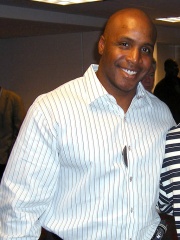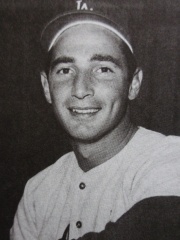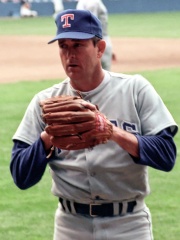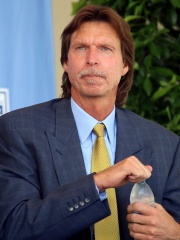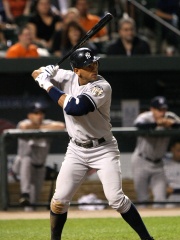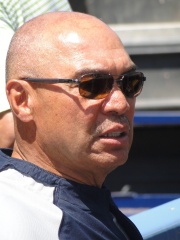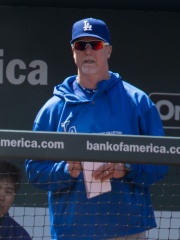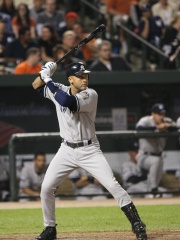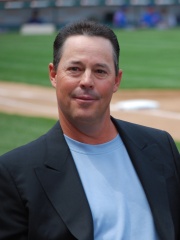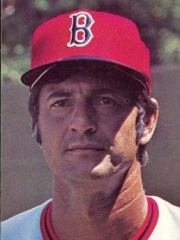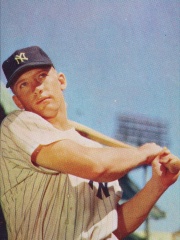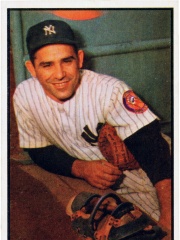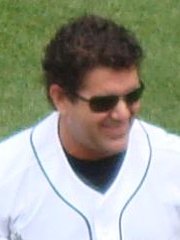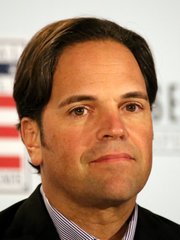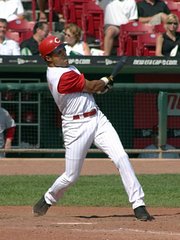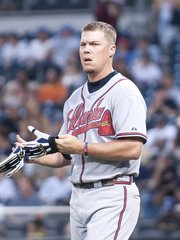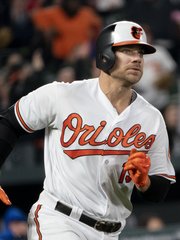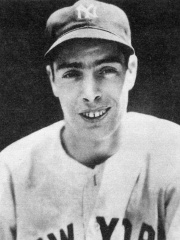
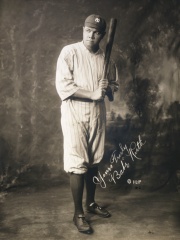
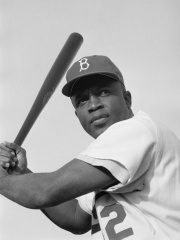
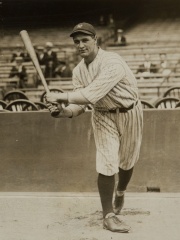
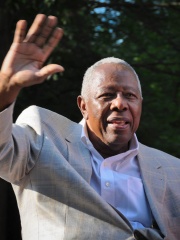
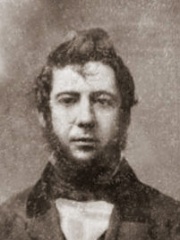
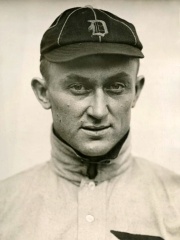
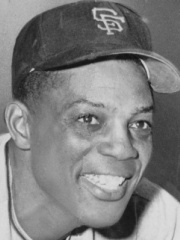
The Most Famous
BASEBALL PLAYERS from United States
This page contains a list of the greatest American Baseball Players. The pantheon dataset contains 91 Baseball Players, 79 of which were born in United States. This makes United States the birth place of the most number of Baseball Players.
Top 10
The following people are considered by Pantheon to be the top 10 most legendary American Baseball Players of all time. This list of famous American Baseball Players is sorted by HPI (Historical Popularity Index), a metric that aggregates information on a biography's online popularity. Visit the rankings page to view the entire list of American Baseball Players.

1. Joe DiMaggio (1914 - 1999)
With an HPI of 71.22, Joe DiMaggio is the most famous American Baseball Player. His biography has been translated into 45 different languages on wikipedia.
Joseph Paul DiMaggio (; born Giuseppe Paolo DiMaggio, Italian: [dʒuˈzɛppe ˈpaːolo diˈmaddʒo]; November 25, 1914 – March 8, 1999), nicknamed "Joltin' Joe", "the Yankee Clipper" and "Joe D.", was an American professional baseball center fielder who played his entire 13-year career in Major League Baseball (MLB) for the New York Yankees. Born to Italian immigrants in California, he is considered to be one of the greatest baseball players of all time and set the record for the longest hitting streak (56 games from May 15 – July 16, 1941). DiMaggio was a three-time American League (AL) Most Valuable Player Award winner and an All-Star in each of his 13 seasons. During his tenure with the Yankees, the club won ten American League pennants and nine World Series championships. His nine career World Series rings put him second only to his fellow Yankee Yogi Berra, who won 10. At the time of his retirement after the 1951 season, he ranked fifth in career home runs (361) and sixth in career slugging percentage (.579). He was inducted into the Baseball Hall of Fame in 1955 and was voted the sport's greatest living player in a poll taken during baseball's centennial year of 1969. His brothers Vince (1912–1986) and Dom (1917–2009) also were major league center fielders. Outside of baseball, DiMaggio is also widely known for his marriage and lifelong devotion to Marilyn Monroe.

2. Babe Ruth (1895 - 1948)
With an HPI of 70.10, Babe Ruth is the 2nd most famous American Baseball Player. His biography has been translated into 61 different languages.
George Herman "Babe" Ruth (February 6, 1895 – August 16, 1948) was an American professional baseball player whose career in Major League Baseball (MLB) spanned 22 seasons, from 1914 through 1935. Nicknamed "the Bambino" and "the Sultan of Swat", he began his MLB career as a star left-handed pitcher for the Boston Red Sox, but achieved his greatest fame as a slugging outfielder for the New York Yankees. Ruth is regarded as one of the greatest sports heroes in American culture and is considered by many to be the greatest baseball player of all time. In 1936, Ruth was elected to the Baseball Hall of Fame as one of its "first five" members. At age seven, Ruth was sent to St. Mary's Industrial School for Boys. In 1914, Ruth was signed to play Minor League baseball for the Baltimore Orioles but was soon sold to the Red Sox. By 1916, he had built a reputation as an outstanding pitcher who sometimes hit long home runs, a feat unusual for any player in the dead-ball era. Although Ruth twice won 23 games in a season as a pitcher and was a member of three World Series championship teams with the Red Sox, he wanted to play every day and was allowed to convert to an outfielder. With regular playing time, he broke the MLB single-season home run record in 1919 with 29. After that season, Red Sox owner Harry Frazee sold Ruth to the Yankees amid controversy. The trade fueled Boston's subsequent 86-year championship drought and popularized the "Curse of the Bambino" superstition. In his 15 years with the Yankees, Ruth helped the team win seven American League (AL) pennants and four World Series championships. His big swing led to escalating home run totals that not only drew fans to the ballpark and boosted the sport's popularity but also helped usher in baseball's live-ball era, which evolved from a low-scoring game of strategy to a sport where the home run was a major factor. As part of the Yankees' vaunted "Murderers' Row" lineup of 1927, Ruth hit 60 home runs, which extended his own MLB single-season record by a single home run. Ruth's last season with the Yankees was 1934, and he retired after a short stint with the Boston Braves the following year. In his career, he led the American League (AL) in home runs 12 times. During Ruth's career, he was the target of intense press and public attention for his baseball exploits and off-field penchants for drinking and womanizing. After his retirement as a player, he was denied the opportunity to manage a major league club, most likely because of poor behavior during parts of his playing career. In his final years, Ruth made many public appearances, especially in support of American efforts in World War II. In 1946, he became ill with nasopharyngeal cancer and died from the disease two years later. Ruth remains a major figure in American culture.

3. Jackie Robinson (1919 - 1972)
With an HPI of 67.64, Jackie Robinson is the 3rd most famous American Baseball Player. His biography has been translated into 50 different languages.
Jack Roosevelt Robinson (January 31, 1919 – October 24, 1972) was an American professional baseball player who was the first African American to play in Major League Baseball (MLB) in the modern era. Robinson broke the color line when he started at first base for the Brooklyn Dodgers on April 15, 1947. The Dodgers signing Robinson heralded the end of racial segregation in professional baseball, which had relegated black players to the Negro leagues since the 1880s. Born in Cairo, Georgia, Robinson was raised in Pasadena, California. A four-sport student athlete at Pasadena Junior College and the University of California, Los Angeles, he was better known for football than he was for baseball, becoming a star with the UCLA Bruins football team. Following his college career, Robinson was drafted for service during World War II, but was court-martialed for refusing to sit at the back of a segregated Army bus, eventually being honorably discharged. Afterwards, he signed with the Kansas City Monarchs of the Negro leagues, where he caught the eye of Branch Rickey, general manager of the Brooklyn Dodgers, who thought he would be the perfect candidate for breaking the MLB color line. During his 10-year MLB career, Robinson won the inaugural Rookie of the Year Award in 1947, was an All-Star for six consecutive seasons from 1949 through 1954, and won the National League (NL) Most Valuable Player Award in 1949—the first Black player so honored. Robinson played in six World Series and contributed to the Dodgers' 1955 World Series championship. He was inducted into the Baseball Hall of Fame in 1962 in his first year of eligibility. Robinson's character, his use of nonviolence, and his talent challenged the traditional basis of segregation that had then marked many other aspects of American life. He influenced the culture of and contributed significantly to the civil rights movement. Robinson also was the first Black television analyst in MLB and the first Black vice president of a major American corporation, Chock full o'Nuts. In the 1960s, he helped establish the Freedom National Bank, a Black American-owned financial institution based in Harlem, New York. After his death in 1972, Robinson was posthumously awarded the Congressional Gold Medal and Presidential Medal of Freedom in recognition of his achievements on and off the field. In 1997, MLB retired his uniform number, 42, across all Major League teams; he was the first professional athlete in any sport to be so honored. MLB also adopted a new annual tradition, "Jackie Robinson Day", for the first time on April 15, 2004, on which every player on every team wears the number 42.

4. Lou Gehrig (1903 - 1941)
With an HPI of 65.43, Lou Gehrig is the 4th most famous American Baseball Player. His biography has been translated into 36 different languages.
Henry Louis Gehrig ( GAIR-ig; born Heinrich Ludwig Gehrig; June 19, 1903 – June 2, 1941) was an American professional baseball first baseman who played 17 seasons in Major League Baseball (MLB) for the New York Yankees. Gehrig was renowned for his prowess as a hitter and for his durability, which earned him the nickname "the Iron Horse", and he is regarded as one of the greatest baseball players of all time. Gehrig was an All-Star seven consecutive times, a Triple Crown winner once, an American League (AL) Most Valuable Player twice and a member of six World Series champion teams. He had a career .340 batting average, .632 slugging average, and a .447 on-base average. He hit 493 home runs and had 1,995 runs batted in (RBIs). He is also one of 21 players to hit four home runs in a single game. In 1939, Gehrig was elected to the Baseball Hall of Fame and was the first MLB player to have his uniform number retired by a team when his number 4 was retired by the Yankees. A native of New York City and a student at Columbia University, Gehrig signed with the Yankees on April 29, 1923. He set several major-league records during his career, including the most career grand slams (23; since broken by Alex Rodriguez) and most consecutive games played (2,130), a record that stood for 56 years and was considered unbreakable until Cal Ripken Jr. surpassed it in 1995. Gehrig's consecutive game streak ended on May 2, 1939, when he voluntarily took himself out of the lineup, stunning both players and fans, after his performance in the field had become hampered by an undiagnosed ailment; it was subsequently confirmed to be amyotrophic lateral sclerosis (ALS), an incurable neuromuscular illness that since then is sometimes referred to as "Lou Gehrig's disease" in the United States. Gehrig never played again and retired in 1939 at age 36. Two weeks later, the ball club held a Lou Gehrig Appreciation Day on July 4, 1939, at the close of which he delivered his speech declaring himself the "luckiest man on the face of the earth" at Yankee Stadium. Two years later, Gehrig died of complications from ALS. In 1969, the Baseball Writers' Association of America voted Gehrig the greatest first baseman of all time, and he was the leading vote-getter on the MLB All-Century Team, chosen by fans in 1999. A monument in Gehrig's honor, originally dedicated by the Yankees in 1941, prominently features in Monument Park at the new Yankee Stadium. The Lou Gehrig Memorial Award is given annually to the MLB player who best exhibits Gehrig's integrity and character.
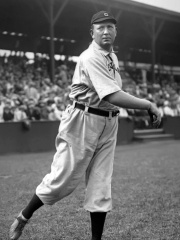
5. Cy Young (1867 - 1955)
With an HPI of 63.52, Cy Young is the 5th most famous American Baseball Player. His biography has been translated into 26 different languages.
Denton True "Cy" Young (March 29, 1867 – November 4, 1955) was an American Major League Baseball (MLB) pitcher. Born in Gilmore, Ohio, he worked on his family's farm as a youth before starting his professional baseball career. Young entered the major leagues in 1890 with the National League's Cleveland Spiders and pitched for them until 1898. He was then transferred to the St. Louis Cardinals franchise. In 1901, Young jumped to the American League and played for the Boston Red Sox franchise until 1908, helping them win the 1903 World Series. He finished his career with the Cleveland Naps and Boston Rustlers, retiring in 1911. Young was one of the hardest-throwing pitchers in the game early in his career. After his speed diminished, he relied more on his control and remained effective into his forties. By the time Young retired, he had established numerous pitching records, some of which have stood for over a century. He holds MLB records for the most career wins, with 511, along with most career losses, earned runs, hits allowed, innings pitched, games started, batters faced, and complete games. He led his league in wins during five seasons and pitched three no-hitters, including a perfect game in 1904. In 1937, Young was elected to the National Baseball Hall of Fame. He is often regarded as one of the greatest pitchers of all time, as well as a pioneer of modern pitching. In 1956, one year after his death, the Cy Young Award was created to annually honor the best pitcher in the Major Leagues (later each League) of the previous season, cementing his name as synonymous with excellence in pitching.

6. Hank Aaron (1934 - 2021)
With an HPI of 63.37, Hank Aaron is the 6th most famous American Baseball Player. His biography has been translated into 50 different languages.
Henry Louis Aaron (February 5, 1934 – January 22, 2021), nicknamed "Hammer" or "Hammerin' Hank", was an American professional baseball right fielder who played 23 seasons in Major League Baseball (MLB), from 1954 through 1976. Considered one of the greatest baseball players in history, he spent 21 seasons with the Milwaukee / Atlanta Braves in the National League (NL) and two seasons with the Milwaukee Brewers in the American League (AL). At the time of his retirement, Aaron held most of the game's key career power-hitting records. He broke the long-standing MLB record for career home runs held by Babe Ruth and remained the career leader for 33 years, until Barry Bonds surpassed his famous total of 755 in 2007. He hit 24 or more home runs every year from 1955 through 1973 and is one of only two players (the other being Alex Rodriguez) to hit 30 or more home runs in a season at least fifteen times. Aaron holds the MLB records for the most career runs batted in (RBIs) (2,297), extra base hits (1,477), and total bases (6,856). Aaron is also third all-time for career hits (3,771) and fifth in runs scored (2,174). He is one of only four players to have at least 17 seasons with 150 or more hits. Aaron's ability as a hitter can be illustrated by his still having over 3,000 hits even without counting any of his home runs. He was an NL All-Star for 20 seasons and an AL All-Star for one season, and he holds the record for the most All-Star selections (25), while sharing the record for most All-Star Games played (24) with Willie Mays and Stan Musial. He was a three-time Gold Glove winner, and in 1957, he won the NL Most Valuable Player (MVP) Award when the Milwaukee Braves won the World Series. Aaron was born and raised in and around Mobile, Alabama, one of eight children. He appeared briefly in the Negro American League and in minor league baseball before starting his major league career. By his final MLB season, Aaron was the last former Negro league baseball player on a major league roster. During his time in Major League Baseball, and especially during his run for the home run record, Aaron and his family endured extensive racist threats. His experiences fueled his activism during the civil rights movement. Aaron was inducted into the National Baseball Hall of Fame in his first year of eligibility in 1982 and Wisconsin Athletic Hall of Fame in 1988. In 1999, MLB introduced the Hank Aaron Award to recognize the top offensive players in each league. That same year, he was one of 30 baseball players elected to the Major League Baseball All-Century Team. He was awarded the Presidential Medal of Freedom in 2002. After his retirement, Aaron held front office roles with the Atlanta Braves, including the senior vice president. He resided near Atlanta until his death in 2021.

7. Alexander Cartwright (1820 - 1892)
With an HPI of 61.69, Alexander Cartwright is the 7th most famous American Baseball Player. His biography has been translated into 16 different languages.
Alexander Joy Cartwright Jr. (April 17, 1820 – July 12, 1892) was a founding member of the New York Knickerbockers Base Ball Club in the 1840s. Although he was an inductee of the Baseball Hall of Fame and he was sometimes referred to as a "father of baseball", the importance of his role in the development of the game may have been exaggerated. The rules of the modern game were long considered to have been based on the Knickerbocker Rules developed in 1845 by Cartwright and a committee from the Knickerbockers. However, later research called this scenario into question. The myth of Abner Doubleday having invented baseball was believed by many, but in Cooperstown in 1939, the myth was debunked. Cartwright (unlike Doubleday) was inducted into the Hall of Fame as a pioneering contributor to the game, 46 years after his death. Although it has been stated that Cartwright was officially declared the inventor of the modern game of baseball by the 83rd United States Congress on June 3, 1953, the Congressional Record, the House Journal, and the Senate Journal from June 3, 1953, did not mention Cartwright.

8. Ty Cobb (1886 - 1961)
With an HPI of 60.75, Ty Cobb is the 8th most famous American Baseball Player. His biography has been translated into 34 different languages.
Tyrus Raymond Cobb (December 18, 1886 – July 17, 1961), nicknamed "the Georgia Peach", was an American professional baseball center fielder. A native of rural Narrows, Georgia, Cobb played 24 seasons in Major League Baseball (MLB). He spent 22 years with the Detroit Tigers and served as the team's player-manager for the last six, and he finished his career with the Philadelphia Athletics. In 1936, Cobb received the most votes of any player on the inaugural ballot for the National Baseball Hall of Fame, receiving 222 out of a possible 226 votes (98.2%); no other player received a higher percentage of votes until Tom Seaver in 1992. In 1999, the Sporting News ranked Cobb third on its list of "Baseball's 100 Greatest Players." Cobb is credited with setting 90 MLB records throughout his career. Cobb has won more batting titles than any other player, with 11 (or 12, depending on who is awarded the 1910 title). During his 24-year career, he hit .300 in a record 23 consecutive seasons, with the exception being his rookie season. He also hit .400 in three different seasons, a record he shares with three other players. Cobb has more five-hit games (14) than any other player in major league history. He also holds the career record for stealing home (54 times) and for stealing second base, third base, and home in succession (4 times), and is still the youngest player to compile 4,000 hits and score 2,000 runs. His combined total of 4,065 runs scored and runs batted in (after adjusting for home runs) is still the highest ever produced by any major league player. Cobb also ranks first in games played by an outfielder in major league history (2,934). He retained many other records for almost a half century or more, including most career games played (3,035) and at bats (11,429 or 11,434 depending on source) until 1974 as well as the modern record for most career stolen bases (892) until 1977. He also had the most career hits until 1985 (4,189 or 4,191, depending on source) and most career runs until 2001. His .366 or .367 (depending on source) career batting average ranked as the highest-ever recorded up until 2024, when MLB decided to include Negro Leagues players in official statistics. Cobb's reputation, which includes a large college scholarship fund for Georgia residents financed by his early investments in Coca-Cola and General Motors, has been somewhat tarnished by allegations of racism and violence. These primarily stem from a couple of mostly discredited biographies that were released following his death. Cobb's reputation as a violent man was exaggerated by his first biographer, sportswriter Al Stump, whose stories about Cobb have been proven as sensationalized and largely fictional. While he was known for often violent conflicts, he spoke favorably about black players joining the Major Leagues and was a well-known philanthropist.

9. Willie Mays (1931 - 2024)
With an HPI of 59.38, Willie Mays is the 9th most famous American Baseball Player. His biography has been translated into 35 different languages.
Willie Howard Mays Jr. (May 6, 1931 – June 18, 2024), nicknamed "the Say Hey Kid", was an American professional baseball center fielder who played 23 seasons in Major League Baseball (MLB). Widely regarded as one of the greatest players of all time, Mays was a five-tool player who began his career in the Negro leagues, playing for the Birmingham Black Barons, and spent the rest of his career in the National League (NL), playing for the New York / San Francisco Giants and New York Mets. Born in Westfield, Alabama, Mays was an all-around athlete. He joined the Black Barons of the Negro American League in 1948, playing with them until the Giants signed him upon his graduation from high school in 1950. He debuted in MLB with the Giants and won the Rookie of the Year Award in 1951 after hitting 20 home runs to help the Giants win their first pennant in 14 years. In 1954, he won the NL Most Valuable Player (MVP) Award, leading the Giants to their last World Series title before their move to the West Coast. His over-the-shoulder catch in Game 1 of the 1954 World Series is one of the most famous baseball plays of all time. After the Giants moved to San Francisco, Mays went on to win another MVP Award in 1965 and also led the Giants to the 1962 World Series, this time losing to the New York Yankees. He ended his career with a return to New York after an early season trade to the New York Mets in 1972, retiring after the team's trip to the 1973 World Series. He served as a coach for the Mets for the rest of the decade before rejoining the Giants as a special assistant to the president and general manager. Mays was an All-Star 24 times, tying for the second-most appearances in history. He led the NL in home runs four times and in slugging percentage five times while batting over .300 and posting 100 runs batted in (RBI) ten times each. Mays was also at the forefront of a resurgence of speed as an offensive weapon in the 1950s, leading the league in stolen bases four times, triples three times, and runs twice; his 179 steals during the decade topped the major leagues. He was the first NL player to hit 30 home runs and steal 30 bases in the same season, the first player in history to reach both 300 home runs and 300 stolen bases, and the second player and the first right-handed hitter to hit 600 home runs. Mays also set standards for defensive brilliance, winning 12 consecutive Gold Glove Awards after their creation in 1957, still a record for outfielders; he led NL center fielders in double plays five times and assists three times. A classic example of a five-tool player, Mays finished his career with a .301 batting average. At the time of his retirement, he held the NL record for career runs scored (2,062), and ranked second in league history behind Stan Musial in games played (2,992), third in home runs (660), at bats (10,881), runs batted in (1,903), total bases (6,066), extra-base hits (1,323) and walks (1,464), fourth in hits (3,293), fifth in slugging percentage (.557), and eighth in doubles (523); his 140 triples ranked fourth among players active after 1945. He holds major league records for games as a center fielder (2,829), putouts as an outfielder (7,095), and ended his career behind only Ty Cobb in total games as an outfielder (2,842), ranking seventh in assists (188) and third in double plays (59) in center field. Mays was elected to the Baseball Hall of Fame in 1979 in his first year of eligibility, and was named to the Major League Baseball All-Century Team in 1999. Mays was awarded the Presidential Medal of Freedom by President Barack Obama in 2015.
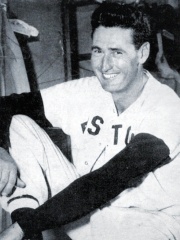
10. Ted Williams (1918 - 2002)
With an HPI of 59.18, Ted Williams is the 10th most famous American Baseball Player. His biography has been translated into 26 different languages.
Theodore Samuel Williams (August 30, 1918 – July 5, 2002) was an American professional baseball player and manager. He played his entire 19-year Major League Baseball (MLB) career, primarily as a left fielder, for the Boston Red Sox from 1939 to 1960; his career was interrupted by military service during World War II and the Korean War. Nicknamed "Teddy Ballgame", "the Kid", "the Splendid Splinter", and "the Thumper", Williams is widely regarded as one of the greatest hitters in baseball history in addition to being the last player to hit over .400 in an MLB season. Williams was a nineteen-time All-Star, a two-time recipient of the AL Most Valuable Player Award, a six-time AL batting champion, and a two-time Triple Crown winner. He finished his playing career with a .344 batting average, 521 home runs, and a 1.116 on-base plus slugging percentage, the second highest of all time. His career batting average is the highest of any MLB player whose career was played primarily after World War II, and ranks 11th all-time. Born and raised in San Diego, Williams played baseball throughout his youth. After joining the Red Sox in 1939, he immediately emerged as one of the sport's best hitters. In 1941, Williams posted a .406 batting average; he is the second-last baseball player to bat over .400 in a season. Williams's career .482 on-base percentage is the highest of all-time. Williams followed this up by winning his first Triple Crown in 1942. Williams was required to interrupt his baseball career in 1943 to serve three years in the United States Navy and Marine Corps during World War II. Upon returning to MLB in 1946, Williams won his first AL MVP Award and played in his only World Series. In 1947, he won his second Triple Crown. Williams was returned to active military duty for portions of the 1952 and 1953 seasons to serve as a Marine combat aviator in the Korean War. In 1957 and 1958 at the ages of 39 and 40, respectively, he was the AL batting champion for the fifth and sixth time. Williams retired from playing in 1960. He was inducted into the Baseball Hall of Fame in 1966, in his first year of eligibility. Williams managed the Washington Senators/Texas Rangers franchise from 1969 to 1972. An avid sport fisherman, he hosted a television program about fishing, and was inducted into the IGFA Fishing Hall of Fame. Williams' involvement in the Jimmy Fund helped raise millions in dollars for cancer care and research. In 1991, President George H. W. Bush presented Williams with the Presidential Medal of Freedom, the highest civilian award bestowed by the United States government. He was selected for the Major League Baseball All-Time Team in 1997 and the Major League Baseball All-Century Team in 1999.
People
Pantheon has 104 people classified as American baseball players born between 1820 and 1997. Of these 104, 79 (75.96%) of them are still alive today. The most famous living American baseball players include Barry Bonds, Sandy Koufax, and Nolan Ryan. The most famous deceased American baseball players include Joe DiMaggio, Babe Ruth, and Jackie Robinson. As of April 2024, 24 new American baseball players have been added to Pantheon including Edgar Martínez, Mike Piazza, and Freddie Freeman.
Living American Baseball Players
Go to all RankingsBarry Bonds
1964 - Present
HPI: 58.68
Sandy Koufax
1935 - Present
HPI: 56.97
Nolan Ryan
1947 - Present
HPI: 56.17
Randy Johnson
1963 - Present
HPI: 56.16
Alex Rodriguez
1975 - Present
HPI: 55.01
Reggie Jackson
1946 - Present
HPI: 54.61
Roger Clemens
1962 - Present
HPI: 53.22
Mark McGwire
1963 - Present
HPI: 52.63
Derek Jeter
1974 - Present
HPI: 52.33
Cal Ripken Jr.
1960 - Present
HPI: 52.28
Greg Maddux
1966 - Present
HPI: 51.93
Carl Yastrzemski
1939 - Present
HPI: 51.38
Deceased American Baseball Players
Go to all RankingsJoe DiMaggio
1914 - 1999
HPI: 71.22
Babe Ruth
1895 - 1948
HPI: 70.10
Jackie Robinson
1919 - 1972
HPI: 67.64
Lou Gehrig
1903 - 1941
HPI: 65.43
Cy Young
1867 - 1955
HPI: 63.52
Hank Aaron
1934 - 2021
HPI: 63.37
Alexander Cartwright
1820 - 1892
HPI: 61.69
Ty Cobb
1886 - 1961
HPI: 60.75
Willie Mays
1931 - 2024
HPI: 59.38
Ted Williams
1918 - 2002
HPI: 59.18
Mickey Mantle
1931 - 1995
HPI: 59.13
Yogi Berra
1925 - 2015
HPI: 58.43
Newly Added American Baseball Players (2025)
Go to all RankingsEdgar Martínez
1963 - Present
HPI: 50.65
Mike Piazza
1968 - Present
HPI: 46.91
Freddie Freeman
1989 - Present
HPI: 44.60
Manny Machado
1992 - Present
HPI: 43.43
Trevor Bauer
1991 - Present
HPI: 42.93
Barry Larkin
1964 - Present
HPI: 42.90
Jacob deGrom
1988 - Present
HPI: 42.62
Chipper Jones
1972 - Present
HPI: 41.72
Chris Sale
1989 - Present
HPI: 39.13
Nolan Arenado
1991 - Present
HPI: 38.73
Cody Bellinger
1995 - Present
HPI: 37.63
Chris Davis
1986 - Present
HPI: 37.09
Overlapping Lives
Which Baseball Players were alive at the same time? This visualization shows the lifespans of the 24 most globally memorable Baseball Players since 1700.

